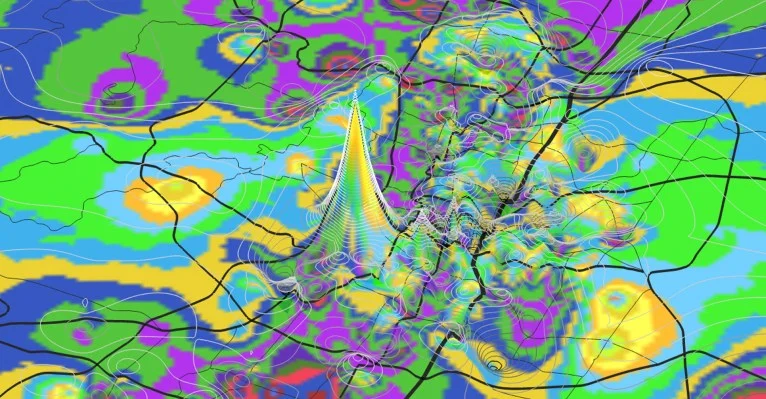They call her a Human Experience Cartographer. Artist Jennifer Chenoweth is mapping community wellbeing in a way that just might blow your mind.
It’s one of the coolest things we’ve come across.
A project that geolocates spots in a community based on the emotional experiences shared by its residents. XYZ Atlas uses story and technology brilliantly to map collective experience in Austin, Texas.
But artist Jennifer Chenoweth didn’t set out to blow your mind. She was simply interested in why people call a place home, and the strong sense of connection to place among those who live in Austin.
Artist Jennifer Chenoweth
“Most of what happens in the art world is a chess game of insular thinking,” she said. “It’s not understood unless you’re a PhD. I pursued art to use the freedoms that I have as a free thinker to inspire others.”
Be glad she did. Picasso once said that the purpose of art is “washing the dust of daily life off our souls.” But Chenoweth takes that dust and gives it a life that speaks of everyday experience in a way that surprises and unites. The project provides a rich snapshot of community wellbeing through intimate stories of identity that both touch and compel those who encounter it.
The genesis of Chenoweth’s projects was a simple color wheel based on psychologist Robert Plutchik’s theory of emotions from the 1970’s. One of Plutchik’s followers assigned it to a color spectrum, which Chenoweth enhanced. The chart, she said, helped her understand emotional wholeness – how all of an individual’s feelings and experiences contribute to being “whole.” Through an interactive question-and-answer series, 503 participants answered a 20-question survey about their life experiences and where they occurred, and thousands more participated in scale-mapping events. The locations were then captured in a mapping system – an X, Y point – and coded to an emotional color on the chart. A Z point indicates whether an experience was positive (a spike on the map) or negative (a valley or drop).
What resulted was an emotional topography of Austin that captures the fabric of community through story. The idea is that when emotion is connected to location, location is no longer space, but place. And place matters. It provides context for the story of our lives, providing a sense of identity and meaning. Place holds our pain and longing, triggering memory or aspiration.
Chenoweth also discovered the work is an active tool for wellness. The map doesn’t tell just the story of happiness, but presents the experience of emotions as a way to understand and accept one’s self, to frame and help healing over trauma. The variety of responses amazed Chenoweth.
“I could get lost in thought for hours, the moral reflection that these stories led to.”
Chenoweth discovered that positive experiences happen in many places, but negative or tragic experiences– a betrayal or abuse – are rooted to a single place.
For example, many people reported positive experiences around a community park – stories around humanity, nature, or love – but traumas are more likely to occur as islands.
“We collectively have positive places but individually have negative places,” Chenoweth said. “Happiness is more about simple joys whereas trauma can wreck your life in one fell swoop.”
Grief occurred most often around the local jail and airport – sunken holes on the map. The bar district was another low point – an area where people lost control or had regrettable memories. The old county hospital also had a lot of negatives associated around the lack of care, waiting, and the way in which people were treated.
“I learned amazing things,” said Chenoweth. “There’s no sound bite to capture it, but there are examples. I took a sculptural representation to SXSW, hanging art with paper and digital surveys and allowing people to walk around and answer the questions with stories. The field opened up with colored flags. One person was on the field for more than an hour and at the end said to me, ‘Thank you. I really needed to do this. I’m in rehab for heroin addiction and I needed to understand how I got here.’”
Since Chenoweth has unleashed XYZ Atlas to the world, others have started to run with it: a local landscape architect is collating stories around bodies of water to map things to the urban landscape; teachers are using the questions as writing prompts to explore difficult topics; and Chenoweth received a second commissioned project on a 12-block section of downtown Austin as well as support to take the project to adjacent cities to do urban planning with minority populations and share their stories.
The Design Institute for Health in Austin is also looking into a project to map patients’ experience around waiting, and institute Director Stacey Chang nominated Chenoweth to do a TEDMED talk. She’ll be speaking at the conference in Palm Springs in November on how her interactive public art project gives individuals and communities an opportunity to be stronger and healthier.
Chenoweth seems a little overwhelmed by the response. “I meant to do this as an art show,” she said. “I’m an artist working for free! I don’t have expertise in these things.
“But it’s delightful and exciting,” Chenoweth said.
Chenoweth is happy to connect with others interested in collaborating or supporting her work. She specifically could use an engineer to help her develop her digital platform around the project. Interested? You can reach out to her through her website: http://www.xyzatlas.org/contact/




